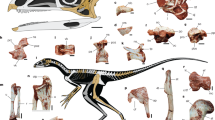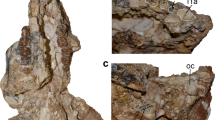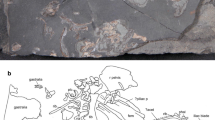Abstract
A COMPLETE skeleton of a large-bodied New World monkey has been found in Pleistocene cave deposits in the Brazilian state of Bahia. It demonstrates an unprecedented combination of body size, locomotor and cranial morphology. Skeletal features indicate an animal of approximately 25 kg, more than twice the mass of any living South American monkey. We refer the specimen to Protopithecus brasiliensis Lund, 1838, a large Pleistocene primate originally represented by only a proximal femur and distal humerus1–4. The skeleton resembles species of two distinct New World monkey lineages. The cranium is modified for an enlarged vocal sac typical of living howler monkeys5–7, and the postcranium includes suspensory and brachiating components of locomotion as seen in living spider and woolly spider monkeys8. This skeleton confirms that adaptive diversity in neotropical primates was greater in the recent past, and that current interpretations of how their distinctive adaptations evolved should be revised.
This is a preview of subscription content, access via your institution
Access options
Subscribe to this journal
Receive 51 print issues and online access
$199.00 per year
only $3.90 per issue
Buy this article
- Purchase on Springer Link
- Instant access to full article PDF
Prices may be subject to local taxes which are calculated during checkout
Similar content being viewed by others
References
Lund, P. W. Det Kong. Danske Viden. Selsk. Natur. Matem. Afhand. 8, 61–144 (1838).
Cartelle, C. Neotrop. Primates 1, 8 (1993).
Cartelle, C. & Ferreira, M. A. C. Acta geol. Leopold XVII, 411–414 (1994).
Hartwig, W. C. J. hum. Evol. 28, 189–196 (1995).
Rosenberger, A. L. & Strier, K. B. J. hum. Evol. 18, 717–750 (1989).
Schön, M. A. Folia primatol. 15, 117–132 (1971).
Schön, M. A. in Symposium on Development of the Basicranium (ed. Bosma, J. F.) 664–677 (U.S. Department of Health Education and Welfare, Bethesda, MD, 1976).
Erickson, G. E. Symp. zool. Soc. Lond. 10, 135–164 (1963).
Mendel, F. Folia primatol. 26, 36–53 (1976).
Schön Ybarra, M. Am. J. phys. Anthrop. 63, 65–76 (1984).
Hartwig, W. C. Hist. Phil. Life Sci. 17, 3–16 (1996).
Ruff, C. B. in Body Size in Mammalian Paleobiology: Estimation and Biological Implications (eds Damuth, J. & MacFadden, B. J.) 119–150 (Cambridge Univ. Press, 1990).
Peres, C. A. J. hum. Evol. 26, 245–250 (1994).
Fleagle, J. G. Primate Adaptation and Evolution (Academic, San Diego, 1988).
Martin, P. S. & Klein, R. G. Quaternary Extinctions (Univ. Arizona Press, Tucson, 1984).
Author information
Authors and Affiliations
Rights and permissions
About this article
Cite this article
Hartwig, W., Cartelle, C. A complete skeleton of the giant South American primate Protopithecus. Nature 381, 307–311 (1996). https://doi.org/10.1038/381307a0
Received:
Accepted:
Issue Date:
DOI: https://doi.org/10.1038/381307a0
This article is cited by
-
Description of a fetal skeleton of the extinct sloth Nothrotherium maquinense (Xenarthra, Folivora): Ontogenetic and palaeoecological interpretations
Journal of Mammalian Evolution (2023)
-
Functional traits of the world’s late Quaternary large-bodied avian and mammalian herbivores
Scientific Data (2021)
-
The Evolutionary History and Genetic Diversity of Kinkajous, Potos flavus (Carnivora, Procyonidae)
Journal of Mammalian Evolution (2017)
-
Phylogeny, Ecology, and Morphological Evolution in the Atelid Cranium
International Journal of Primatology (2015)
Comments
By submitting a comment you agree to abide by our Terms and Community Guidelines. If you find something abusive or that does not comply with our terms or guidelines please flag it as inappropriate.



